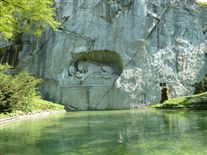Photos_-_1635.jpg
The Lion of Lucerne - Click 'Details' for more informatio
Memorial
The initiative to create the monument was taken by Karl Pfyffer von Altishofen, an officer of the Guards who had been on leave in Lucerne at that time of the fight. He began collecting money in 1818. The monument was designed by Danish sculptor Bertel Thorvaldsen, and finally hewn in 1820–21 by Lukas Ahorn, in a former sandstone quarry near Lucerne.
The monument is dedicated Helvetiorum Fidei ac Virtuti ("To the loyalty and bravery of the Swiss"). The dying lion is portrayed impaled by a spear, covering a shield bearing the fleur-de-lis of the French monarchy; beside him is another shield bearing the coat of arms of Switzerland. The inscription below the sculpture lists the names of the officers, and approximate numbers of the soldiers who died (DCCLX = 760), and survived (CCCL = 350).[2]
Before completing the monument, the artist, Bertel Thorvaldsen, was told that not enough money had been raised to pay for his services and that he would not be fully paid for his work. Thorvaldsen wanted to make a public statement about his disdain for the situation. Out of respect for the fallen soldiers he chose not to damage the sculpture itself and decided instead to change the shape of the nook the lion lay inside. The outside edge remains in the shape of a pig to this day; a subtle but clear message of his feelings.[citation needed]
The pose of the lion was copied in 1894 by Thomas M. Brady (1849–1907)[3] for his Lion of Atlanta in the Oakland Cemetery in Atlanta, Georgia.
